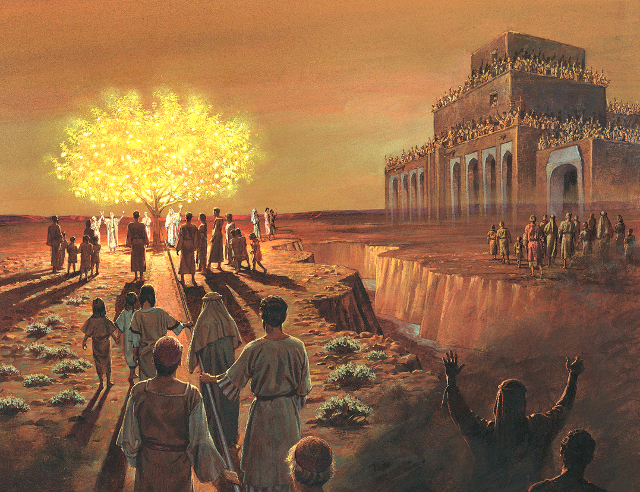
by John P. Pratt
25 Nov 2019, 13 Monkey (SR), 1.IX (Toltec)
©2019 by John P. Pratt. All rights Reserved.
|
1. Lehi's Path 1.1 The Man in White 1.2 The Iron Rod 2. Great and Noble 2.1 Abraham 2.2 Moses 2.3 Elijah 2.4 John the Baptist 2.5 Joseph Smith 2.6 Mauricio Berger 2.7 Denver Snuffer 3. "Come Unto Christ." 4. False Prophets 5. "We follow Moses!" 6. Coming False Christ 7. Conclusion Notes |
Can you recite Lehi's famous dream about the Tree of Life in the Book of Mormon (1 Nephi 8:4-10)? How about the first part, describing in some detail just how Lehi arrived at the tree? Do you remember that part? That part is almost always entirely overlooked because it is so counterintuitive and difficult to explain. All of the details of the second half of the dream were explained to his son Nephi (1 Nephi 11-12), so that is the part which has been the focus of most Book of Mormon students. It seems clearly to represent the best path for most of humanity, who were seeking to find it, yet it was not the path for Lehi. Why not?
 |
So just how did Lehi arrive at the Tree of Life? Let's read the account as recorded by his son Nephi:
I saw in my dream, a dark and dreary wilderness. And it came to pass that I saw a man, and he was dressed in a white robe; and he came and stood before me. And it came to pass that he spake unto me, and bade me follow him. And it came to pass that as I followed him I beheld myself that I was in a dark and dreary waste. And after I had traveled for the space of many hours in darkness, I began to pray unto the Lord that he would have mercy on me, according to the multitude of his tender mercies. And it came to pass after I had prayed unto the Lord I beheld a large and spacious field. And it came to pass that I beheld a tree, whose fruit was desirable to make one happy. -- 1 Nephi 8:4-10
 |
After knowing the rest of the dream, one can ask, why didn't he follow the straight (not "strait" D&C 3:2) and narrow path to the tree grasping the iron rod like everyone else? Doesn't everyone have to follow the same path?
Who was the man in white? There are several clues to help us understand. White is a universal symbol of righteousness so apparently Lehi either knew or assumed this man was righteous. The man requested that Lehi follow him. As this article progresses, it will be seen that this simple request is a grand key to understand who the man is. The implication is that he either was a religious leader to be trusted or he claimed to be such. Apparently Lehi followed him in hopes of being led on a path of righteousness, perhaps to ultimately find further light and knowledge, understanding of the mysteries of God, or other joyful reward for a good life.
What happened was a huge disappointment, being almost a disaster for Lehi. Instead of being led into a beautiful heavenly realm, he found himself in a "dark and dreary" wasteland! He continued following the man, apparently in the hope that it was just a difficult trail which would ultimately lead to joy, but after many hours he realized it was not going to get any better!
Finally, Lehi cried out to the Lord to have mercy on him and save him from his predicament, which he found himself in because of following the man in white!
What was the lesson for Lehi to learn from this dream vision? Perhaps there were many lessons. First, just because a man wears white does not necessarily mean that the man was righteous. He might have been, as Lehi had assumed, or he may have been intending to deceive. Second, even if the man in the white robe was righteous, having good intentions to lead Lehi to truth, something went very wrong. Another lesson might well have been not to trust his salvation to any other man at all! Finally, the lesson of what ultimately worked was for Lehi to cry unto the Lord for mercy himself, not following any man whatsoever. That worked instantly, bringing him to the Tree of Life.
Is that the path for everyone? Apparently not, because Lehi was shown the path which was set up for the vast majority of people to follow. Let us consider it.
Lehi saw that the path for most people was first to find the beginning of the path, which apparently many never found at all. He saw "numberless concourses" of people searching for the beginning of the straight and narrow path leading to the tree with the delicious fruit (1 Nephi 8:21). Once on the path there was a rod of iron provided to lead one along the path.
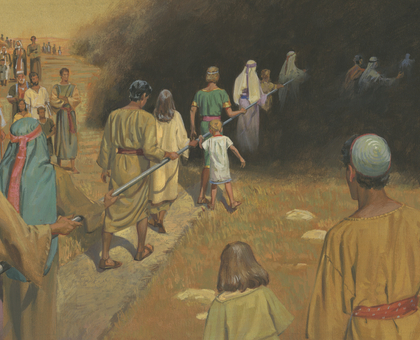 |
So what did the iron rod represent? It was explained to Nephi that it was the "word of God" (1 Nephi 11:25). That is usually assumed to mean the scriptures, but that is not what was said. The rod is the true word of God, which is contained in the scriptures, but which also can be found in the heart of those who are prepared and willing to hear it.
Thus, a way has been provided for all mankind to arrive at the delicious fruit alone, provided that they can find the beginning of the path and then have the humility to realize they will likely be lost if they do not tightly grasp the iron rod!
Now let us consider why Lehi's path was different from most of humanity.
There were three types of beings in the great meeting before this world began: intelligences, spirits, and souls (Abr. 3:22-23). The intelligences were spirit children of Heavenly Father and Mother who were wanting to have the experience of coming to earth to gain a body and to be proven to see if they would keep all of God's commandments.
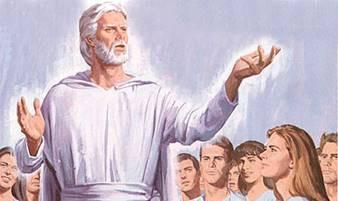 |
The souls in that meeting were apparently already resurrected beings because a soul has a spirit and body (D&C 88:15). The Lord saw that both the spirits and the souls were "good", which was apparently not true of all of the intelligences present because many chose to follow Lucifer and oppose the plan of the Father.
God stood among some great and noble spirits and souls and declared that these would become his rulers. Abraham was one of those chosen leaders (Abr. 3:22-23).
This is being reviewed here because these leaders had already passed earlier probations and had proven worthy of being chosen leaders to help others along the path. Thus, it appears possible that the path represented by the rod of iron and straight and narrow path is in a sense especially for those intelligences who had not yet achieved being "spiritually born", as well as fulfilling other requirements, in order to graduate from the cycles of rebirth in multiple mortalities. The illustration shows the 20-step veintena of the Sacred Round calendar. It appears to be the same as what the Tibetans called the Wheel of Life and others have called the Eternal Round. The focus of the intelligences is mostly on the downward half of its 20-step cycle (on the right side of the illustration) focusing mostly on birth (Temple), spiritual rebirth (Serpent), death (Skull), and then descending into the depths of spirit prison if they did not qualify to qraduate (Dog).
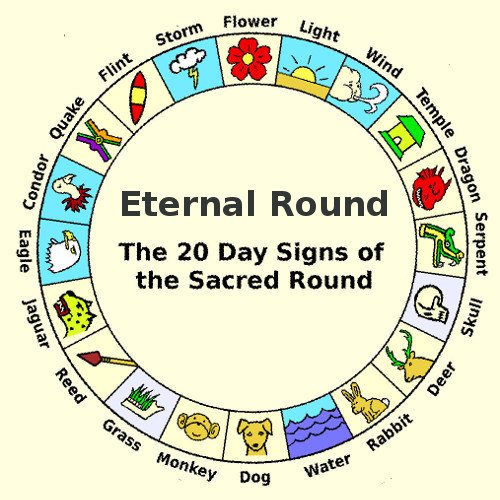 |
The point of all of that is to understand that these great and noble leaders have already passed the easier test of hiking along a path through darkness by holding on to a handrail along the way. It is here proposed that many of these leaders, who came to earth to be born again into a mortal life to help others and achieve a more excellent resurrection (Heb. 8:6, 11:35), have a more difficult path to follow. Lehi was one of those great and noble spirits. According to the current understanding of the 20 steps of the Eternal Round shown in the illustration, the last seven after resurrection (Reed) all refer to different steps on Jacob's ladder up to heaven (Gen. 28:12).[4]
Apparently one level of the harder tests, which must be achieved to ascend Jacob's ladder, is to learn to follow only the Lord even when there are highly respected religious leaders (the man in the white robe) telling people to "follow them" because they can lead you to eternal life. The key to who the man in the white robe represents is the fact that he requested Lehi to "follow" him.
Can you think of scriptural examples of any of the Lord's prophets who told people to follow them? True prophets call their listeners to repentance and tell them to worship and obey the Lord! If Christians, they command us to "Come unto Christ!" The lesson of Lehi's fruitless journey in following the man in the white robe shows that doing such will often result in ending up in a dark and barren wilderness. It was when Lehi, in desperation, finally understood that he needed to cry directly unto the Lord for help that he was immediately granted the desire of his heart.
Let us now consider several of the great and noble spiritual leaders which the Lord sent down to earth to help intelligences along their paths. Each of these leaders needed to recognize that their spiritual leaders were worshipping false gods or interfering with their followers coming to Christ. They needed to seek out the true God for themselves, against great opposition, and then help others to worship that one true God. None of these men recommended following themselves, but rather only God.
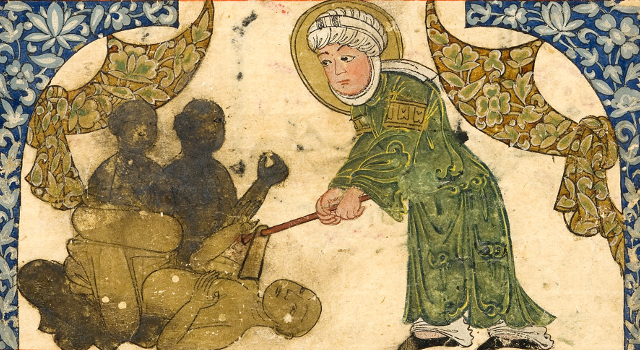 |
Thus, Abraham is an example of man who chose to go against all of the heathen customs of his day in order to commune directly the true and living God. The illustration from the teachings of Islam, and also the Book of Jasher, shows Abraham chopping up the idols of his father. Afterwards, he left the axe in the hands of one of the idols and claimed that he did it. When his father replied that was ridiculous because they have no power, Abraham asked his father why he worshipped them! Eventually his father was converted enough to leave the country with Abraham.
In the study of sacred calendars, it was discovered that Abraham was born in a double Decision Day year, representing having to decide whether of not to follow the true God.[5]
Moses is another example of a great leader who had the courage to leave all of the idolatrous religion in which he was raised in the court of Egyptian Pharaoh and learn to follow the true and living God. He also had to go against the customs of his father-in-law Jethro who did not want him to circumcise his sons.
Moses wanted all of his people to get to know God personally. He did not want them to follow him as a leader. However, they refused to know God, so the higher priesthood was removed from them. Although it was not his desire, he did allow them to follow him and become an intermediary between them and God. He is an example of a true prophet who led his people, but he was truly leading them to Christ. When he led them, he emphasized only the necessity of following the commandments of God. Nevertheless, they became such adamant followers of Moses, that they crucified the Savior because they had decided to follow only Moses (John 9:28-29)!
Elijah was another very strong prophet who challenged all of the prophets of Baal in order to show to the Israelites that Jehovah was a much stronger god than the false gods and idols of the country (1 Kings 18:21). Again, Elijah did not ask the people to follow him, but only to return to the worship of Jehovah.
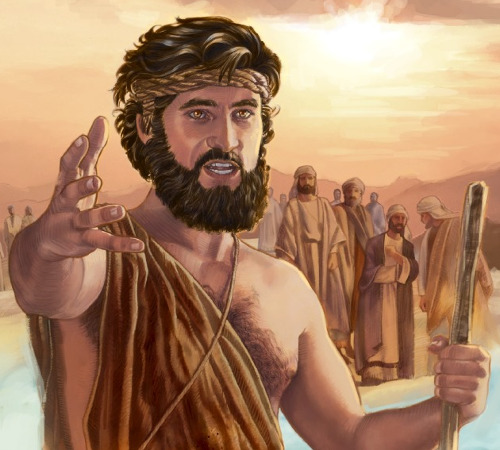 |
As for not following his corrupt Jewish religious leaders, John had been ordained to overthrow the kingdom of the Jews when he was eight days old (D&C 84:28). Jesus was baptized by John as an outward sign that He acknowledged that John then held the keys of the short dispensation of the Meridian of Time.
Joseph Smith the Seer was another who chose to try to know God personally. He saw the confusion in his day of so many churches all claiming to be true, then he decided not to follow any one pastor, but to accept the counsel of James (James 1:5) and go to the Lord directly in prayer to ask which church he should join.
It turned out that his path was much like the other prophets discussed. He was not to join any of the existing churches, nor follow any man, but was to follow only God who would give him revelations and send him angels in order for him to begin a new church patterned after the one begun by the original apostles of Jesus Christ.
Following the pattern of Lehi's dream, in an address to the Relief Society Joseph emphasized the importance of NOT depending on the prophet too much, as doing such would darken their minds and cause them to fall, if they ceased to depend individually on the Lord:
President Joseph Smith read the 14th chapter of Ezekiel--said the Lord had declared by the Prophet, that the people should each one stand for himself, and depend on no man or men in that state of corruption of the Jewish church--that righteous persons could only deliver their own souls--applied it to the present state of the Church of Jesus Christ of Latter-day Saints--said if the people departed from the Lord, they must fall--that they were depending on the Prophet, hence were darkened in their minds, in consequence of neglecting the duties devolving upon themselves, envious towards the innocent, while they afflict the virtuous with their shafts of envy. -- TPJS p. 237-238.
Instead of Church members following himself, Joseph the Seer preached the importance for those in his Church to seek to obtain the more sure word of prophecy directly from God (TPJS, p. 299), and the Second Comforter which meant the personal visitation of Jesus Christ (TPJS 150-151). Everything in the Church was done in order to bring people to Christ. That is also the principal message of the Book of Mormon (2 Nephi 31:19-20). The Church is simply a tool to bring members to Christ and to learn to get along in a community to prepare to live with Jesus Christ and the Father someday in the Kingdom of God.
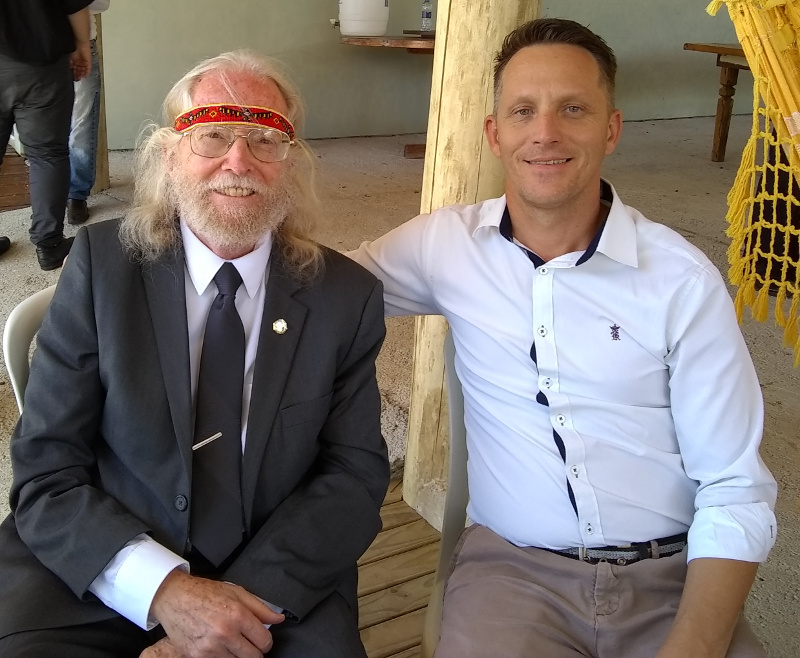 |
Over the years that Mormon Church has gradually stopped teaching many of the important doctrines emphasized by Joseph Smith. Instead it has introduced the concept of "Follow the Prophet", referring to whoever the current LDS Church president might be. That concept is nowhere found in scripture. Many fundamental teachings have been abandoned and the High Priesthood after the Order of Melchizedek has been lost ever since the times of the second president Brigham Young. The Church president is supposed to be chosen from the quorum of high priests (D&C 107:22), who held that higher priesthood, but Brigham Young was only an apostle, only having the same priesthood as an elder (D&C 20:38). He chose to begin the teaching that the apostles were the highest authorities in the Church and proceeded to make that become true by ordaining nearly all of the high priests to be seventies, whose calling it is to serve the apostles.
In recent years the Lord has sent the Angel Moroni, still the keeper of the golden plates of Mormon from the which the Book of Mormon was translated by Joseph Smith, to ordain Mauricio Berger of Brazil again to be a high priest in order to revitalize the Church begun by Joseph Smith. Moreover, Mauricio was also commissioned to translate more of the plates of Mormon using the Urim and Thummim, by the gift and power of God. Those are the top few of the many plates which had been sealed until it was time for them to come forth. As in the time of Joseph Smith, there were recently three witnesses who saw Angel Moroni and the plates, and eight more who witnessed the breaking of the upper seal. (The largest portion of the plates are to remain sealed until opened by the Savior himself.) These first plates translated contain teachings which are needed at this time, including how high priests should act and how having all things in common was successfully implemented by the Nephites. Those teachings are definitely needed for our times to prepare for Zion, because the first high priests at the time of Joseph mostly were excommunicated, and both Joseph and Brigham failed to successfully succeed having all things in common. The first part of the translations of those previous sealed plates are now available in Portuguese and English as The Sealed Book of Mormon. In an earlier article of mine it is concluded that the book is indeed genuine.[6].
Mauricio had been a member of the Mormon Church before being called to this new assignment. That means he had been strongly conditioned to "follow the prophet", that is, to follow the "man in white", the LDS Church President, as his spiritual leader. The details are not known to me of just how he learned that he must overcome this false tradition and learn to follow only Christ, his angels, and the Holy Ghost, but I'm familiar with the power of the conditioning and the difficulty it can be to awaken that we are to answer only to God and not to man (Acts 5:29). Hence Mauricio fits the pattern of the other great and noble leaders being described.
Last week was the first world conference of this fledgling church which was attended by some sixty members. I was invited to come to participate, which opportunity was accepted in order to meet Mauricio and see for myself what is going on there. It is my report that Mauricio is indeed a seer (Mosiah 8:15-17). When he addressed the audience, his face shone and his words came directly from the Spirit. It was reminiscent of the descriptions of the power with which Joseph Smith himself spoke.
Moreover, most of the members of the Church there appeared to already have two of the most important attributes required by members of Christ's true Church: (1) they had true love for each other and (2) they were childlike! That latter requirement of the doctrine of Christ (3 Nephi 11:38) is overlooked by nearly all Christians and rarely even mentioned, even though Jesus taught that without it, even his apostles could not enter the Kingdom of Heaven (Mat. 18:3)!
I returned with a strong belief that Mauricio is a seer and that he indeed translated the golden plates by the gift and power of God! While there I was baptized by Mauricio to acknowledge that I accept him as the leader of a new dispensation of the gospel!
 |
David gave a series of ten lectures in different cities in Utah, which were given to him directly by the Lord. They were compiled into a book called Preserving the Restoration. The last of those lectures explained that it was necessary for all, including Mormons, to be baptized again exactly as prescribed in the Book of Mormon, in order to acknowledge his leading a new dispensation. I was baptized that same month in September 2014, for it was clear that he spoke truth. Thus, I believe that I am member of two different dispensations, much like someone in the days of Jeremiah and Ezekiel could recognize both of them as prophets who were called of God to preach repentance in different places. Interestingly, David predicted that there would be another dispensation, running concurrently with his own, which would focus on continuing the teachings of Joseph Smith.[7] Mauricio is apparently fulfilling that prophecy!
The assignments of David and Mauricio appear to be different. David is attempting to gather a people who are covenanting directly with God, without starting a church. His principal assignment seems to be to prepare them to build a temple in which the highest ordinances of the fulness of the priesthood can be performed. That was the same assignment that Joseph Smith was trying to fulfill when he was martyred, namely to finish the Nauvoo temple where the fulness of the priesthood could be restored which had been lost by the Church (D&C 124:28). That temple was never completed, so that priesthood has not yet been restored, hence the need to finish that work today. In contrast, Mauricio said he will not be building a temple, but is revitalizing the Church started by Joseph Smith. Thus, their assignments do not appear to compete with each other, but instead to work together to prepare to the Second Coming of Jesus Christ!
Like Abraham, David was also born in a double Decision Day year,[8] representing that he, like Abraham, would have to decide whether to follow the traditions of the LDS Church, or accept the calling from the Lord to correct errors which have crept into the Church, in order to prepare a people to accept the Savior.
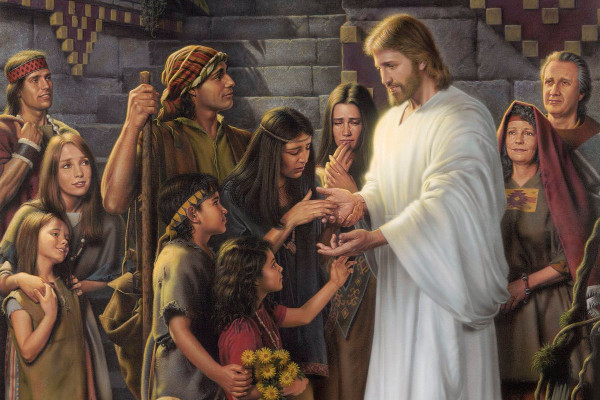 |
For the purposes of this article, however, the one sign which appears to be the lesson which Lehi was being taught, is that a true prophet will encourage people to come to Christ directly, without need for an intermediary. They will not set themselves up as anything special other than a teacher of the word of God.
If a true prophet makes a mistake and unwittingly does takes honor to himself, the consequence can be severe indeed. Moses made one mistake along these lines and was severely chastised by the Lord. In fact, he was punished by not being allowed to enter the Promised Land.
What was his mistake? In reviewing past miracles, he made the mistake of saying that he, Moses, had produced the water from the rock which provided the much needed water as he led the children of Israel into the wilderness. The people were already prone to idolize Moses, so this was a grave error. He should have given all of the credit to the Lord. Compare that to all of the modern healers who claim that they themselves are healing people, not giving credit to where it is due.
The New Testament, the Book of Mormon, and the Sealed Book of Mormon all teach the importance of only following Jesus Christ! It is a huge lesson for all to learn, including the noble leader Lehi!
What are the signs of a false prophet, one in a white robe who is either knowingly or unknowingly leading people into a dark and dreary wilderness?
There are many very typical signs. One is that they have produced no fruits. Instead, people are encouraged to following them because of the "good feelings" felt in his presence. Another sign nearly always present is that they flatter people, telling how chosen and righteous they are. Their followers give prayers of gratitude for their righteousness (Luke 18:11-12, Alma 31:16-18). True prophets do the opposite, calling their hearers to repentance.
I personally know a self-proclaimed prophet who was going around accompanied by evil spirits who could make people feel really good, so they would mistake those feelings for the presence of the Holy Ghost, especially if they had been taught that Holy Ghost is accompanied by such feelings. Joseph Smith taught the Holy Ghost often brings absolutely no feelings: "This first Comforter, or Holy Ghost, has no other effect than pure intelligence" (TPJS p. 149). It simply expands the mind with pure light, truth, and understanding. One big clue that he was a false prophet was that he would ordain any man to be one of the 144,000 (Rev. 7:4) if the man did nothing more than ask to be ordained. How can we be so gullible as to think that is all that is required? Thus, false prophets and spirits nearly always appeal to one's pride or desire for power.
False prophets also change ordinances or say they are not needed. Jesus made his doctrine very clear that baptism is required and that the sacrament should be held often. Both have fixed forms which he commanded not to be altered (3 Nephi 11:22). The man whom I just described was offering a new "higher" baptism with a new prayer. Isaiah prophesied that one of the signs of false prophets in the last days would be that they would change ordinances (Isa. 24:5).
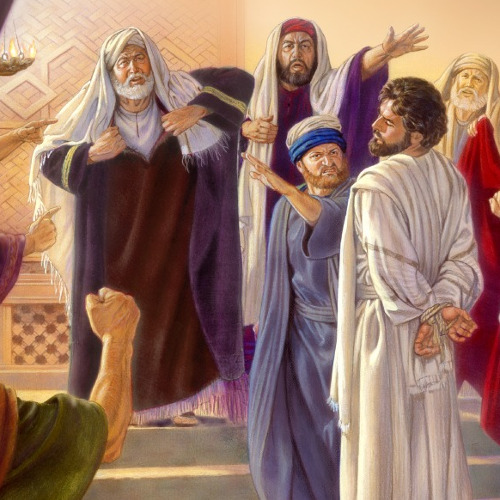 |
When the Lord described to Joseph Smith exactly who would be going to the lowest part of the kingdom of heaven (telestial), he included an interesting group along with the liars, adulterers, and whoremongers. He also included:
For these are they who are of Paul, and of Apollos, and of Cephas. These are they who say they are some of one and some of another--some of Christ and some of John, and some of Moses, and some of Elias, and some of Esaias, and some of Isaiah, and some of Enoch; But received not the gospel, neither the testimony of Jesus, neither the prophets, neither the everlasting covenant. -- D&C 76:99-101
Think about that! Those who say they follow Enoch, Moses, John the Baptist, or St. Paul will end up with the liars, thieves and unrepentant criminals. They do not go the higher terrestrial kingdom, which is for the honorable men of the earth who were deceived by the craftiness of men (D&C 76:75).
Notice something else. That quoted scripture includes Christ on the list of true prophets not to follow. But how can that be? Are we not to follow Jesus? Notice that it is possible to idolize Christ too, meaning to hold him as a false idol. The scripture says they claim to be of Christ (Christians) but they receive not the gospel nor the everlasting covenant (such as baptism). Thus, they are followers in word only which is apparently worse than being a good person in a heathen nation without law who has never heard of Jesus and yet is honorable, because they can inherit the terrestrial kingdom (D&C 76:72).
It should probably be added that when someone is first introduced to the gospel, it is often good to have a mentor to help answer questions and teach the gospel. There is certainly a place for Sunday School teachers. Even though the neophyte may follow that mentor at first, the goal should always be to help the student grow into a strong independent believer, completely weaned off the teacher.
The test for Christians which is coming will be the great Anti-Christ who is yet to reign. The scriptures make it sound like he will claim to be the real Messiah and that he will bring peace to the world. He will deny Jesus of Nazareth as being the Messiah because he will claim that he is the Messiah, which the Jews have been waiting for all of this time.
If this is how it plays out, then this presents a new "man in the white robe" challenge. This time the test will not be to worship nor follow a false prophet, nor a true prophet. This time it will be not to follow someone who says he is the real Messiah, the Son of God.
So how is one to know? Again it should be clear from the fruits he produces and his methods of spreading his "gospel". If it is done by force, executing non-believers, then that will be a big clue!
The first part of Lehi's dream of the Tree of Life is analyzed with the intent of understanding just who the man in the white robe was who led Lehi into a dark and dreary wilderness. Lehi was in such distress that he cried unto the Lord for deliverance, whereupon he saw the Tree of Life. The question was considered as to the meaning of this counterintuitive way to arrive at the tree, when most of the world had to find the beginning of the straight and narrow path and then hold onto the iron handrail.
First, it was concluded that the man in white was someone who Lehi accepted as a religious leader who could lead him to further light and knowledge. He was greatly disappointed in that hope. Lehi's salvation came when he prayed to the Lord directly. Another big clue was that the man in white asked Lehi to follow him. Thus, it was concluded that the lesson for Lehi was to follow no man, even a true prophet, but for him to develop his own relationship directly with Jesus Christ. That was the lesson for Lehi, but not necessarily for all. When people are first introduced to the gospel they might choose to follow someone, but that leader should wean them off his help as soon as possible. The path to the Tree of Life has no leader; it is a dangerous hike through darkness, guided only by a handrail.
The three types of beings in the pre-existence were discussed and it was concluded that Lehi would fall into the category of one of the great and noble who were chosen to be the leaders in this world. That means that Lehi had already lived in at least one previous mortal probation, implying that he did not need to follow the usual path to the tree of life. He had already passed that test previously. This time he would condescend to return to help others, while he advanced up one more rung of Jacob's ladder by passing a harder test. That would be the test of graduating from following any religious leader in order to develop his own personal relationship with Jesus Christ. He did that admirably, and indeed, in the New World, which was his inheritance, he would become the religious teacher to help others to "Come unto Christ!"